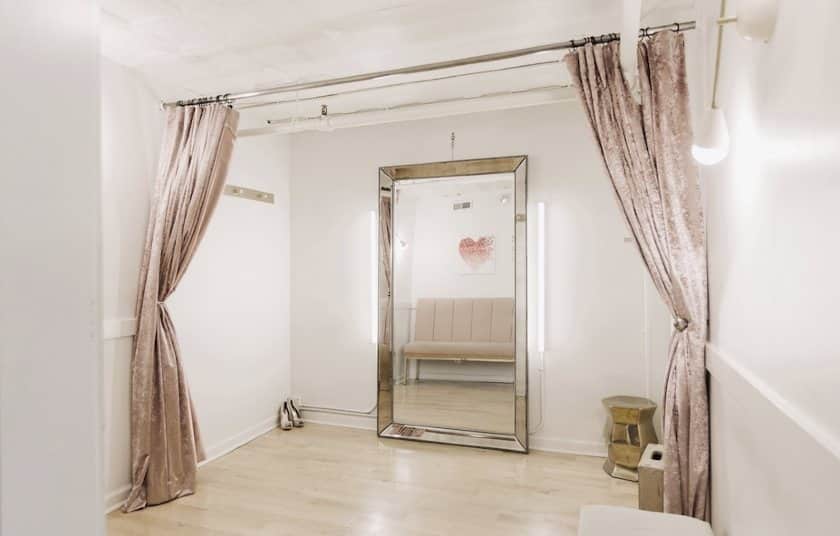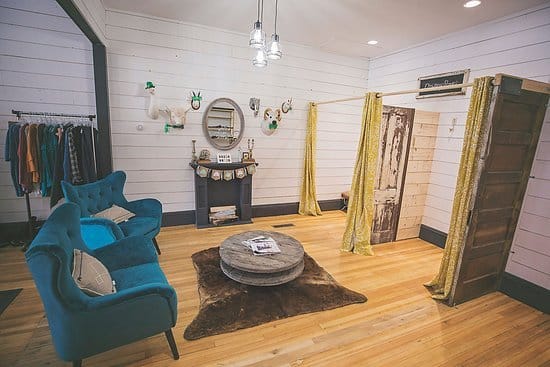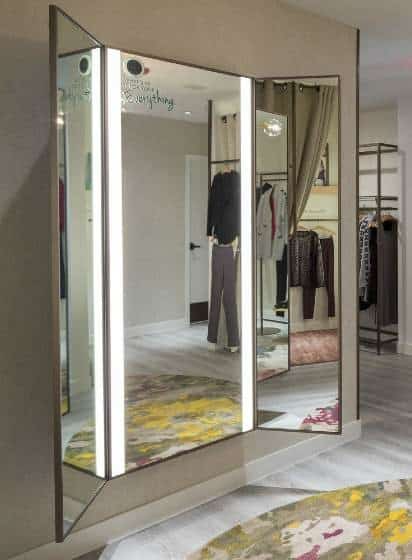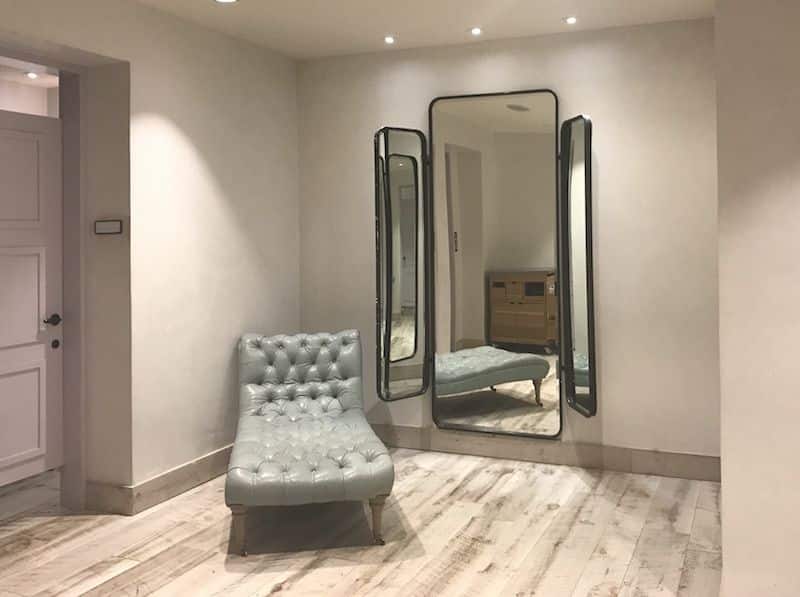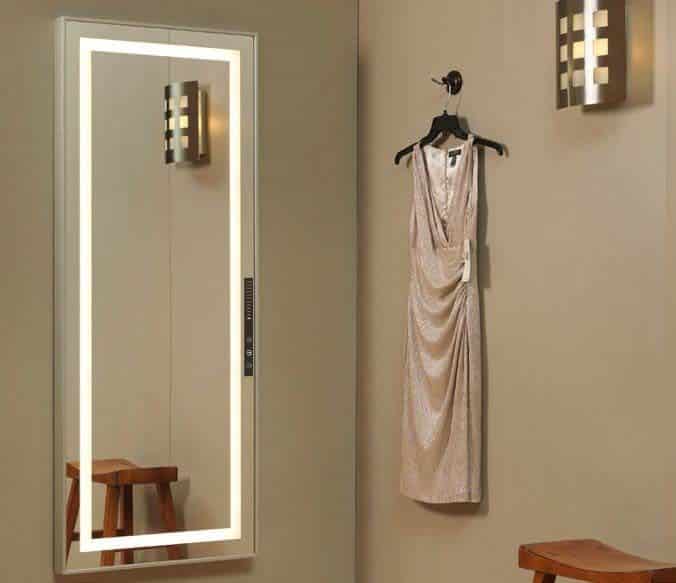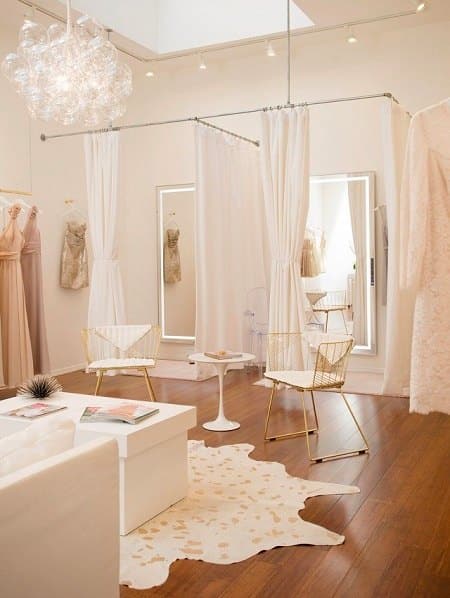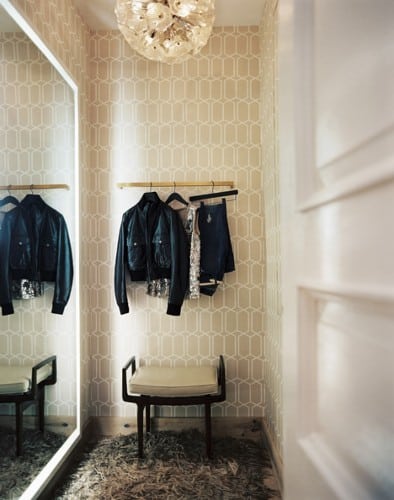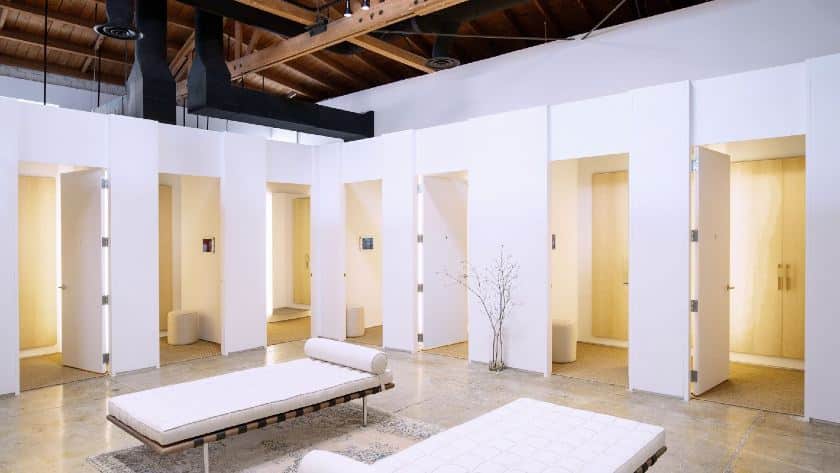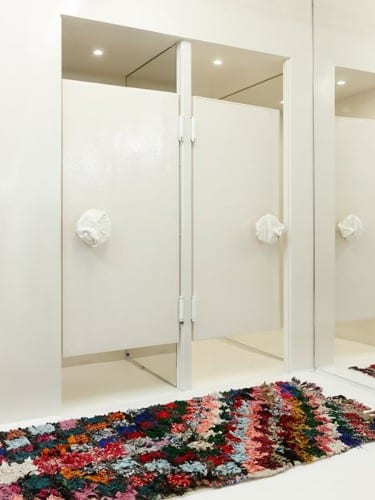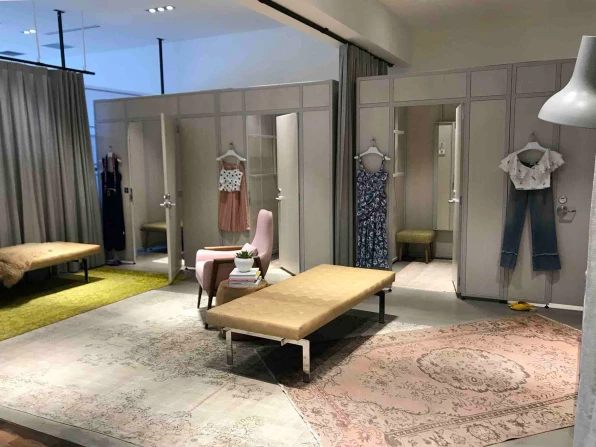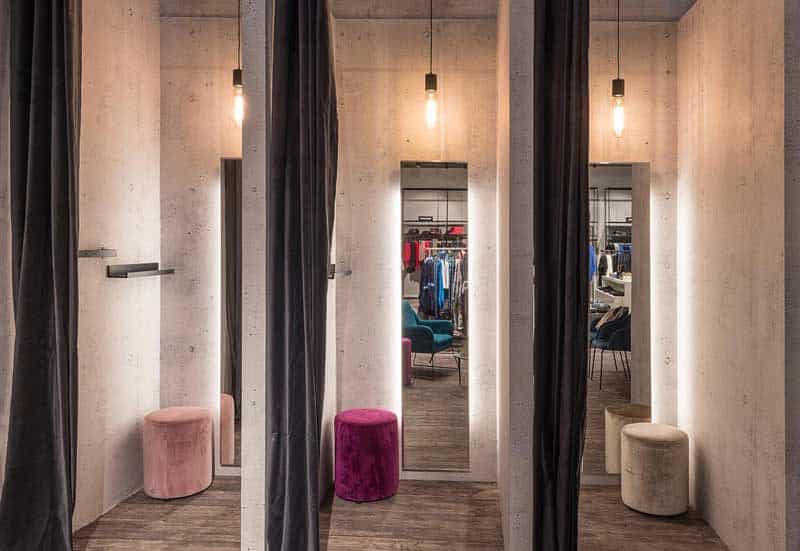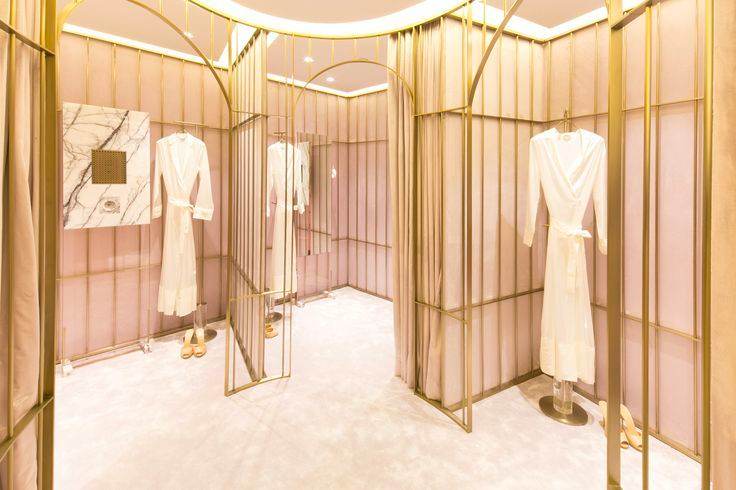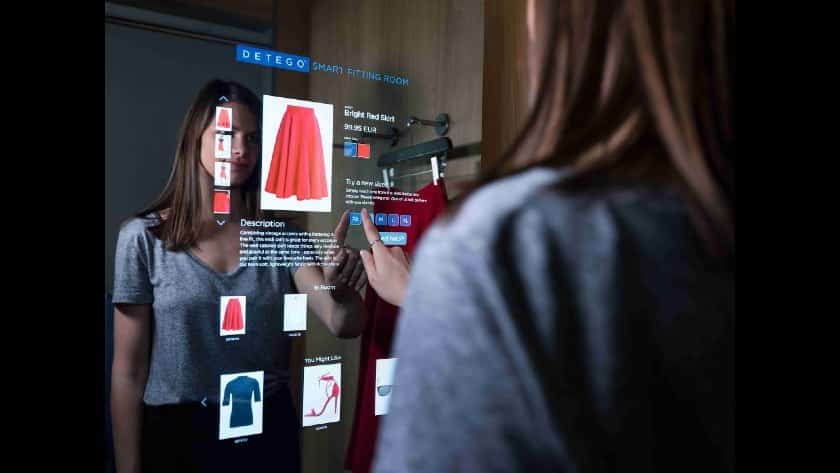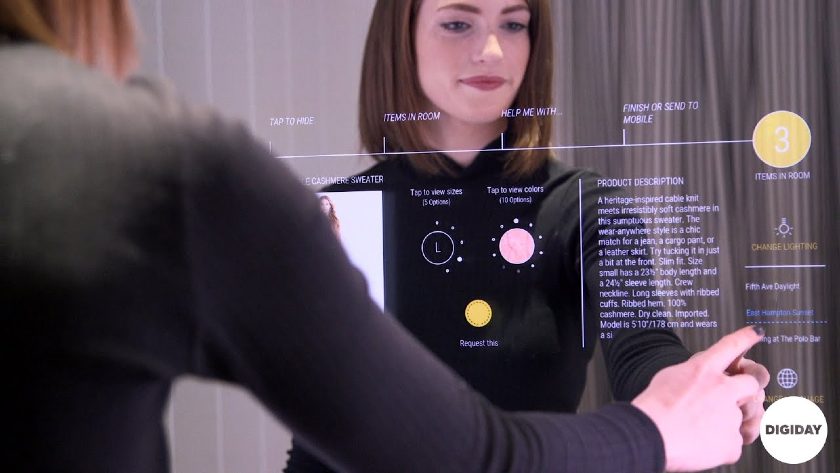A well-designed and inviting fitting room will incentivize shoppers to use your fitting spaces, improve your customer experience, and, in turn, drive sales.
With good design and exciting features, you can make your fitting rooms one of the highlights of your business. Follow the fitting room ideas and tips below to set your fitting rooms up for success.
1. Space & Place Your Fitting Rooms
Before you can begin designing your fitting rooms, you have to determine their size and location. The primary function of a fitting room is to provide a space for customers to try on apparel, so you want to be sure that they can do this without bumping into walls or fixtures. Let’s go over what you should consider and best practices for placing and spacing your fitting rooms.
2. Follow ADA Requirements
In addition to leaving enough space for activities in your fitting rooms, you should ensure that they are compliant with section 803 of the Americans with Disabilities Act (ADA). It includes information about proper hook heights, seating, door closure, and floor space, which will help you guarantee that your fitting rooms are welcoming to all. Following these guidelines will also ensure that you do not incur any fees or penalties for breaking the ADA’s requirements.
3. Use Neutral Lighting
Proper lighting in your fitting rooms will make or break how well customers see themselves in your pieces and is one of the most important elements in creating a well-designed fitting room. In retail lighting, we often refer to the lighting in fitting rooms as task lights.
Typically, you will provide each fitting room with its own task light either above the space as a pendant light or in the space as a sconce. Installing lights in each room will ensure that customers have good visibility in their space and that lighting is not blocked when fitting doors are closed.
When choosing bulbs for your fitting room, you want to be sure that you are using a type that is as neutral and natural as possible. Dark, overly bright, or colored lighting might blow out or hide details, creating a false impression of what your clothes actually look like—potentially leading shoppers to distrust your brand. Conversely, neutral lighting is the most flattering and presents products in their best and most accurate light.

Each fitting room is lit by its own light source to create a bright and inviting space. (Source: The Every Girl)
Experiment with different lighting solutions to find one that works best in your space. It will depend on many factors, including natural light, ambient light, and the layout of your store. You can also check out our lighting guide for more information on lighting your space. Our article also includes a breakdown of the different lighting types and fixtures at your disposal.
4. Install Mirrors: Reflection & Placement
Mirrors are probably the most important element of your fitting rooms. Shoppers use mirrors to evaluate how your products work for them, and they can make or break how customers feel in your clothing. Invest in quality mirrors and place them well throughout your store to drive sales and improve customer experience.
5. Keep Your Colors Consistent, Neutral & Bright
You want the color of your fitting room to coordinate with the rest of your store. Opt for neutral tones and patterns and use light colors that reflect light well. These tactics will help you present your merchandise better and sell more of it, as your fitting rooms will blend into the background and you will avoid distracting customers shopping on the floor.
Additionally, choosing a neutral color or wallpaper for your fitting rooms will allow customers to focus on the clothing and how it looks without being distracted by a bright color or pattern. Textured wall designs, subtle patterns, and muted colors are a good option if you want to incorporate color or patterns into your fitting rooms.
Finally, use light colors in your fitting rooms to make them appear more spacious and to enhance your lighting. Light colors reflect light better than dark ones (making your light source more effective), brighten the area, and create an illusion of a bigger space—dark tones can make a room feel crowded.
6. Add Seating
When adding fixtures to your fitting rooms, one of the most important pieces to include is seating. A chair or bench will provide customers somewhere to sit and maneuver in and out of clothing, a place to put their things, and somewhere for another shopper to sit if they are sharing a room. All in all, seating helps make shopping easier and improves customers’ experience.
Often you will see bench seating in fitting rooms. A bench creates a hybrid seating and table arrangement to maximize both sitting and storage space in your fitting rooms. If not a bench, you will generally see a small chair designed to take up minimal space to avoid infringing on the changing area. If you do choose a chair instead of a bench, be sure to add additional storage options like hooks or a side table to ensure there is a good place for customers to put their things.
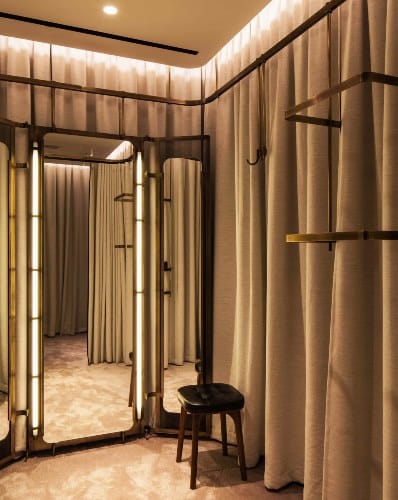
A stool and hanging bars create places for customers to sit and put their things on. (Source: 7btin)
In addition to providing a seat inside of your fitting rooms, you also want to be sure that there is seating in their vicinity. Typically, you want to provide two to five seats to accommodate larger parties, depending on your space. Seating outside of fitting rooms is great for fellow shoppers and gives companions a convenient place to watch their friends show off their clothes.
My boutique had two large armchairs that sat outside of the fitting room area. We affectionately called them the “boyfriend chairs” because they were the default position for boyfriends and spouses as their partners would come out of the fitting rooms and show them their outfits.
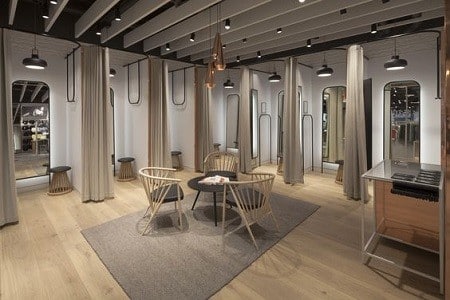
A seating arrangement outside of these fitting rooms creates the perfect spot for companions to sit and watch their friends try on clothes. (Source: VMSD)
7. Create Privacy
One of the most important things for ensuring that your customers will walk away with a good impression of your fitting rooms is privacy. Whether you install doors, curtains, or another barrier, you want to be sure that shoppers feel comfortable and secure when they are using your fitting rooms.
In terms of entry coverings, the most popular options are curtains, half doors where there is a gap underneath and above, or full doors.
Curtains are typically the most popular option for small businesses due to their low installation cost, ease of placement, and space-saving abilities. The biggest thing with curtains is to be sure you order enough fabric to cover the entire entry. I would suggest ordering curtains that are several feet longer than the width of your entry to avoid gapping issues and ensure customers feel secure.
Half doors are slightly more expensive but can be locked, adding a layer of security for your shoppers. Full doors are the costliest option and typically require the installation of a free-standing structure if you do not have fitting rooms already built into your store. They are, however, the most private door option and give your customers the most luxurious experience.
8. Provide Hanging Options
In addition to providing a spot for people to keep their personal belongings, you should install hanging spaces for customers to place the clothing they have picked. While some companies opt for a single hanging bar for a space-effective hanging solution, I would suggest installing several hooks and bars and even labeling them.
As people try items on, they will generally have their original picks and their yes, no, and maybe options. Providing labeled bars or hooks for each of these categories will help your shoppers stay organized and maintain order in their space.
Additionally, this hook strategy will make it easier for customers and sales associates to clean out fitting rooms, as all the items that are going back onto the floor will be in one spot. An empty room will incentivize shoppers to try on more items and help to drive your sales.

A store labels its hooks with “Possibly” and “Definitely” to help shoppers stay organized. (Source: Reddit)
9. Decorate With Minimal Fixtures
While there are certain necessary decors like seating and storage, you should not overwhelm your fitting rooms with them. Your fitting rooms should be highly utilitarian, offering only the fixtures that facilitate the fitting process and avoiding all else. Additional elements take up unnecessary space, impede on changing, and distract customers from their selection.
When setting up your fitting rooms, ask yourself whether anything is distracting or superfluous in your changing space. If the answer is yes, remove it! Utilitarian minimalism does not mean your fitting rooms can’t be stylish. You can always choose fun lighting, floor coverings, seating, and wall colors. The big takeaway is that the things you put in your fitting rooms should serve a purpose and not take up otherwise functional space.
10. Keep the Temperature Cool
One way you can be sure to drive customers out of your fitting rooms is by making them too hot. Trying on clothes involves a lot of movement and, often, the layering of multiple items over another. If your fitting rooms are too hot, changing and trying clothes will become unpleasant for your customers and can make them have unfavorable views of the pieces they try and can even deter them from trying things on in the first place.
11. Staff Your Fitting Rooms
As we mentioned earlier, customer-associate interactions are an excellent asset for driving sales, and you should be facilitating those interactions wherever you can. One of the best places to do this is in the area around your fitting rooms.
Staff one to two people around your fitting rooms at all times to provide services like grabbing another size off the floor, helping with zippers and ties, answering customer questions, and styling shoppers.
The area around your fitting room is one the most common places where customers will look for help and have questions. Be sure that you are prepared for that and ready to capitalize on all the customer-associate interactions that are sure to come.
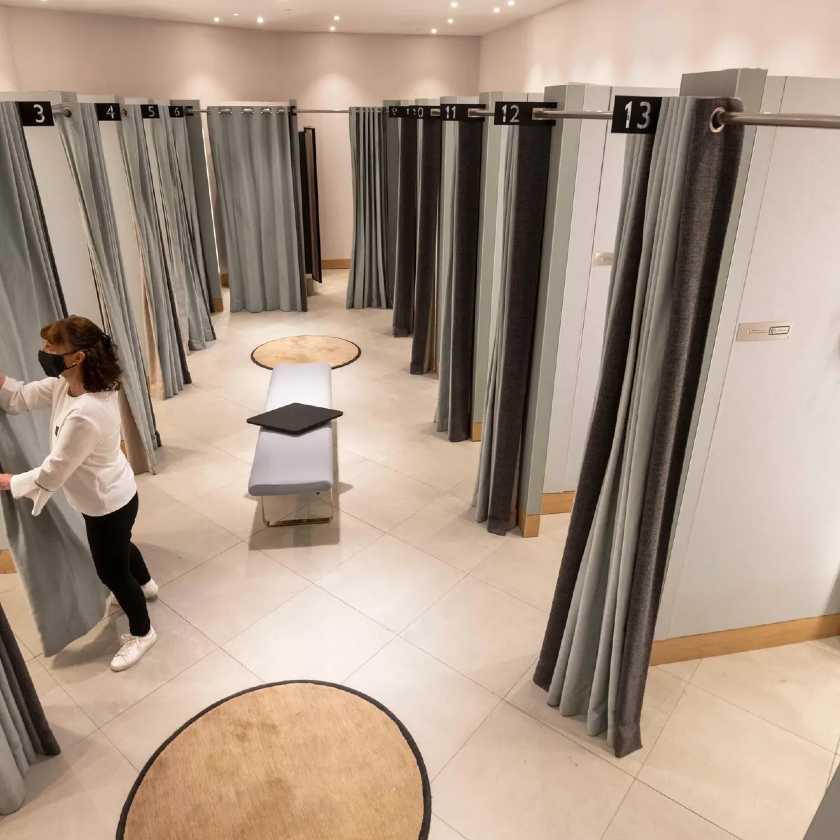
A sales associate is ready to assist shoppers as they try things in their fitting rooms. (Source: The Guardian)
12. Advertise Exciting Offers on Social Media Channels
By the time a customer enters your fitting room, they are already a captive audience, connecting with your brand, and at the precipice of a purchase. You should capitalize on this moment with advertisements, social media plugs, and loyalty programs to remind customers of opportunities and help drive your sales.
For example, in my boutique’s fitting rooms, we hung flyers that advertised our social media channels. We knew that the fitting room audience had connected with our business and would be interested in keeping up with us on Instagram and Facebook. Our signage capitalized on this connection and helped our channels grow.
Additionally, we had other flyers that advertised our discounts and sales. These ads were great because they reminded customers about the potential for deals when they were deciding whether to make a purchase, making them more inclined to buy.
While you should use your fitting rooms to promote your social media and loyalty programs and remind customers of deals and discounts, your displays should not distract them. Make your displays small, hang them in your customers’ line of sight, and use options that are flush with the wall. Doing this will maximize visibility without creating a distraction or impeding foot space.
Use digital displays, paper signage, posters, or framing options for your fitting room displays. For more on the different display types for your business, check out our comprehensive guide to merchandising and displaying your products and signage.
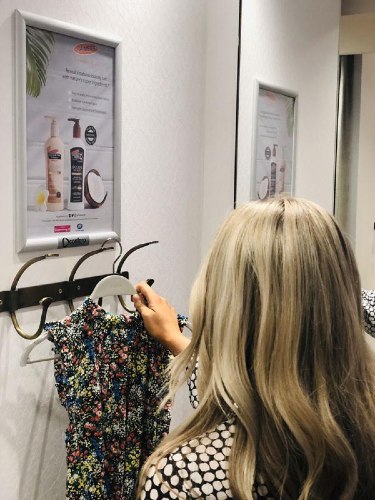
An ad for a new lotion is located above where customers hang their clothes. (Source: Confero Marketing Logo)
- Influencer Marketing Campaigns for Small Business Promotion
- Social Media Marketing Statistics to Power Your Strategy
- How to Sell on Instagram
- Selling on Facebook Shops & Facebook Marketplace
- How to Sell on TikTok
13. Keep Your Fitting Rooms Tidy
You want to be sure that you have no distractions in your fitting area so that customers can focus on the products and nothing else. This includes using decor and design but also means that you should be diligently keeping your fitting rooms clear of any clutter and debris.
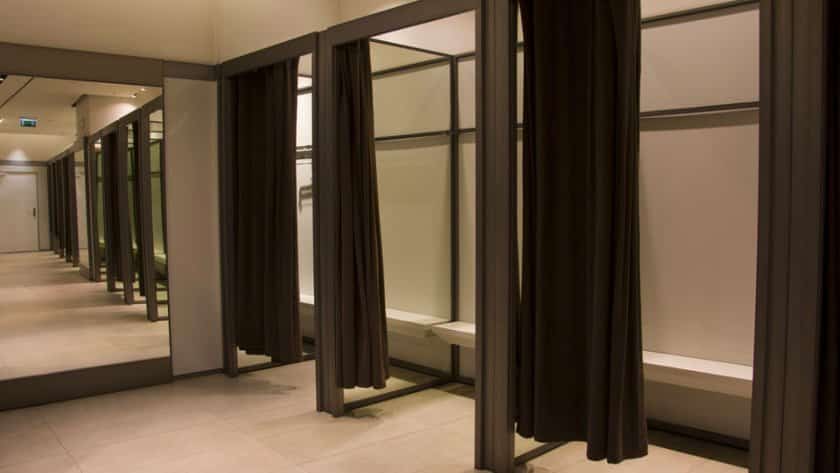
Clean fitting rooms give customers a blank slate for trying on products and will keep them from distractions. (Source: Retail TouchPoints)
To ensure that you have tidy fitting rooms at all times, you should institute regular cleaning routines both at the end of each day and in between customers.
- In In-between customers: Remove all clothes from a previous try-on and any miscellaneous items and trash that a customer might have forgotten or dropped. This will ensure that new shoppers have a fresh space to come into and there is no evidence of prior use.
- End-of-day cleaning: At the end of each day, fitting rooms should be completely clean, mirrors should be wiped down, and all fitting surfaces should be sanitized. Your fitting rooms are more mess- and dirt-prone than other zones, so a thorough cleaning each day will ensure that they stay fresh day over day.
Your end-of-day fitting room cleaning is also a great time to look for signs of theft. Shoplifters will often use the privacy of fitting rooms to remove security tags and prices from products, so check for these items to detect signs of stealing.
14. Lower Your Music
To make it easy for shoppers to chat between rooms and discuss pieces as they try on, you should keep your music lowered in your fitting areas, compared to the rest of your store. For larger stores with fitting rooms removed from the rest of the shopping space, this is easy—just adjust your music for the fitting room zone or don’t play any at all.
For stores where your fitting rooms are within the shopping space, you will have to think harder about how to get the volume lower in the fitting rooms. In my store, we strategically placed our speakers away from the fitting rooms to help the try-on zone stay quieter, but you might also use a sound system where you can adjust your volume for different areas.
The best way to ensure your music isn’t disruptive for the try-on process is to try it out yourself and to ask your shoppers. In my experience, if you ask for feedback, customers are more than happy to provide. Couple that with your own trials, and you should be able to nail down the right volume and speaker arrangement.
15. Create Photo Ops
As we all know, people love to take pictures of themselves, and if you can create a photo-worthy spot in your fitting area, this will not only draw people in for the photo op but will also inspire customers to share their pictures on social media. This sharing, in turn, is a great way to reach new customers and build brand recognition.
To create a photo op in your fitting space, start with a great mirror. Most people don’t have large full-length mirrors at home, so a stylish full-body mirror is a great place to begin. From there, you might add a fun wallpaper behind the mirror or a sign to make it unique.
I also suggest incorporating your brand name in the photo op area somewhere, for the free marketing potential, and keeping small accessories, like sunglasses and hats, in your fitting space. These are simple things that customers can throw on to enhance their photos (or even inspire an add-on purchase).
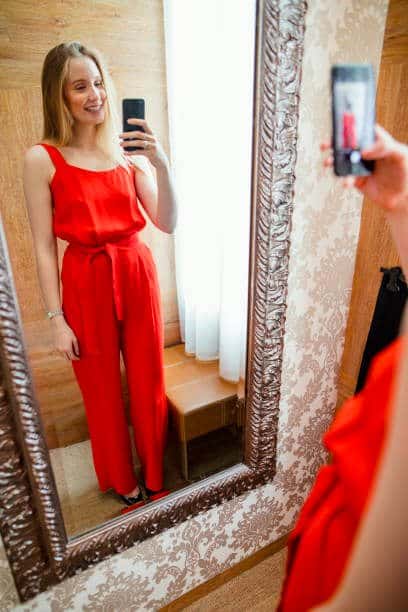
A customer takes a fun selfie for social media in this beautiful mirror. (Source: Pinterest)
16. Incorporate Fitting Room Technology
Fitting rooms are one of the ways that brick-and-mortar retailers set themselves apart from their ecommerce competitors. Even with the growing desire for convenience and at-home shopping, nearly half of consumers still prefer to shop in-store rather than online for the experience of interacting with the products and utilizing in-store services like fitting rooms.
However, the ecommerce market is getting increasingly high-tech and is doing more to give shoppers the perks of in-store shopping online. As the online market gets more competitive, businesses should consider integrating technology into their fitting rooms to create an exciting experience, make shopping easier, and continue to attract traffic.
Below, we will look at some of the features that fitting room tech can bring to your business.
17. Set Up Fitting Rooms for Mobile Operations
Even if you run a mobile operation, such as a pop-up, you can reap the benefits of offering a fitting room to your customers by setting up a mobile fitting room. In most cases, these look like collapsible metal structures with curtain attachments that create an enclosed space. The simple contraptions are light, easy to transport and store, and are available on Amazon.
In addition to the fitting room structure itself, you will also want to invest in some sort of carpet or mat to place over the concrete, grass, or whatever other surface on which you are setting up shop. Additionally, you will want to get some sandbags or other weights to hold down your fitting room on windy days.
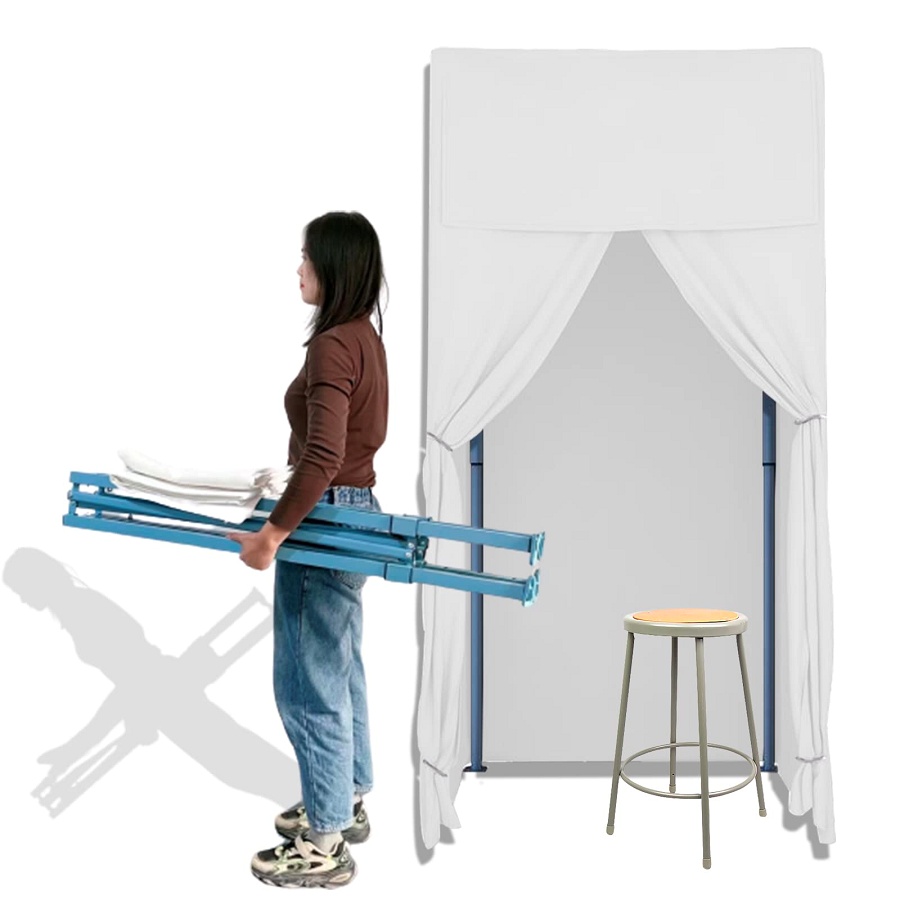
Mobile fitting rooms are a great option if you have a mobile store or do pop-ups. (Source: Amazon)
In the News: Fitting Rooms Tech
As the online landscape becomes more competitive, large retailers are rolling out innovative fitting room technology to compete in the retail space. Here, we will take a look at three examples of fitting room technology in the news so that you can stay on top of industry trends.
Reformation
Reformation, a popular women’s clothing retailer, started out as an ecommerce brand but has been opening brick-and-mortar locations in recent years as it has seen success. In order to incentivize people to come shop in their physical storefronts rather than just online, Reformation has equipped their stores with incredible tech, including in their fitting rooms.
Each Reformation fitting room is designed to look like a high-end walk-in closet, with all your shopping selections hung up for you in the “wardrobe” before you come in. From there, there is a place to charge your phone and play your personal music as well as different light settings, so you can really set the mood you want.
And, you can’t forget the tablet mounted to each fitting room wall, where you can view all the store’s merchandise, swap sizes for things you already have, and request items directly to your room. Simply close your wardrobe, add your requested items, and the wardrobe will cue you when your items are there and it’s time to open. Customers report these features make them try on and buy more than they ever would have otherwise.
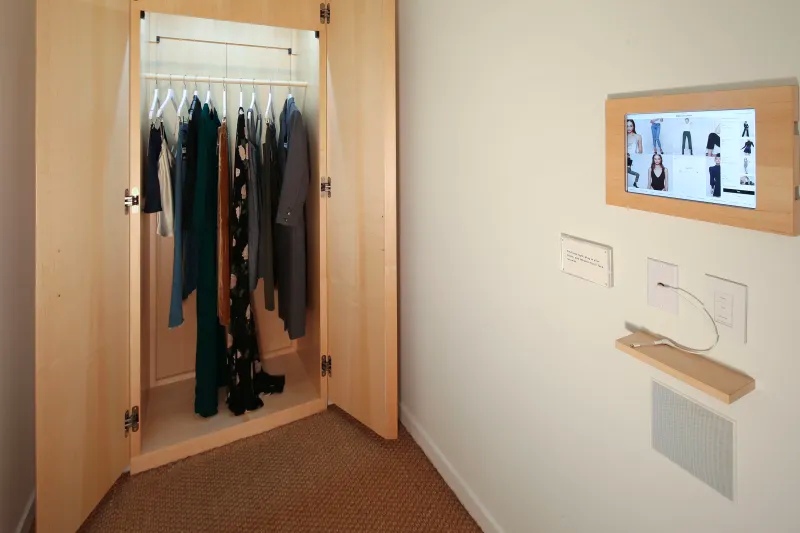
The tech in Reformation’s fitting room drives engagement and sales. (Source: WWD)
Walmart & Zeekit
As Walmart has been working to establish itself as a fashion destination, it acquired Zeekit, a leader in digital fitting room technology, in 2021 and began rolling out innovative online fitting tech.
With Zeekit, customers shopping on the Walmart app or Walmart.com have the opportunity to choose from over 70 models of different skin colors, hair, heights, and body types and view how different products look on them, The idea here is to make online shopping easier and more reliable and to fill the gap that fitting rooms provide by giving shoppers a better idea of how items will look on models that have similar appearances to themselves.
Walmart is also working with Zeekit to bring a virtual try-on experience to women’s apparel but does not have an expected rollout date yet.

Walmart partnered with Zeekit to launch the Choose My Model feature where customers can choose from over 70 to find one that reflects their size, height, hair, and skin color. (Source: Industry Update)
Neiman Marcus & Smart Mirrors
As the luxury retailer was flailing at the start of the COVID-19 pandemic, Neiman Marcus’s head of innovation rolled out smart mirrors in some of its major stores. As we looked at before, with these mirrors, customers can stand in their reflection and virtually select and try on different pieces without ever actually changing their clothes.
Customers get a 360-degree view of themselves in different outfits and can even record multiple try-ons and then view them side by side to make final purchase decisions. Not only that, but Neiman Marcus is incorporating smart mirrors into its cosmetics area, allowing staff makeup artists to record their application process and then email the tutorial to customers for reference.
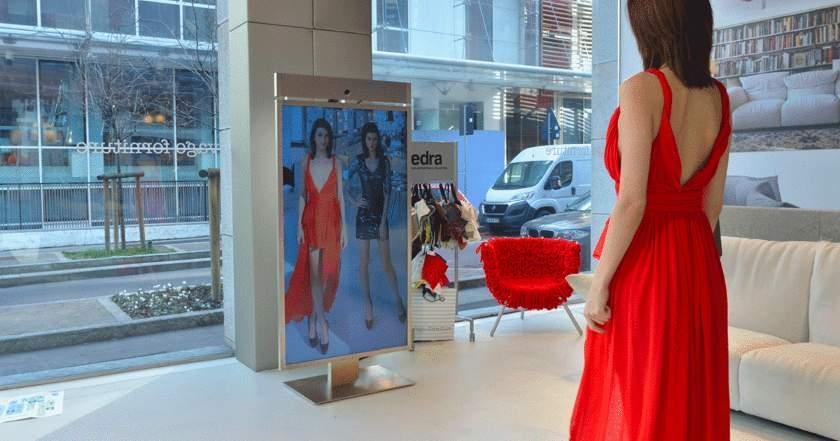
Neiman Marcus’s smart mirrors let you try on outfits without ever actually changing your clothes and compare different looks side by side for making tough buying decisions. (Source: CBS)
Frequently Asked Questions (FAQs)
Click through the questions below to get answers to some of your most frequently asked fitting room design questions.
A good fitting room has adequate lighting, enough space for customers to move around, a neutral color palette, some seating, a mirror or mirrors, and hanging options. Bonus points if the fitting room includes technology like smart mirrors or an associate request button.
A fitting room is where customers go to try on clothes and a changing room is where parents can change their children’s diapers or help them go to the bathroom.
You should incorporate a fitting room into your store layout by placing it toward the back of your store and installing partitions between each space during your store layout design process. If you need to add a fitting room to a store with a preexisting layout, you can place your fitting rooms and add partitions to an existing store with curtains or a larger construction project.
Bottom Line
Fitting rooms are an essential part of starting your retail business, and with the right design and features, they are an excellent tool for driving sales and creating a positive customer experience. The power of fitting rooms is undeniable and can drive customers from their computers and into your store. Use the tips above and incorporate the right design elements, and your fitting rooms will drive your business forward.

